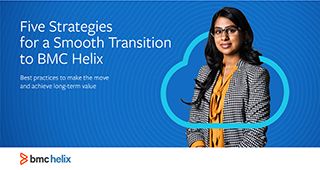Digital transformation is driving a parallel transformation in software support, with software as a service (SaaS) playing an important role in disrupting traditional support practices.
Replacing an on-premises solution with a SaaS offering like BMC Helix can yield many benefits—CapEx to OpEx, steady stream of updates, and new functionality—for the customer. However, the accelerated pace of updates means customers have less time to absorb the new features and functionality. Vendors like BMC are reinventing their support strategies to focus on accelerating broad adoption of their SaaS solutions within customer organizations to help bridge the “SaaS consumption gap”.
Flipping the traditional support model upside down
SaaS is turning the traditional support model on its head. Traditional support is structured in tiers—typically Levels 1, 2, and 3. In this model, users contact the service desk, Level 1, where agents are skilled to handle routine issues, but not much more. To reach in-depth expertise, you have to wait for Levels 2 and 3, but you have to go through Level 1 first. The new SaaS model makes the most experienced and skilled agents the first point of contact for end users by leveraging three key elements:
- Dispatch swarming
- Automation
- Self-help
Dispatch swarming
Dispatch swarming applies the talents of multiple people to fast-track resolutions. Instead of an individual taking on a case and then passing it up the ladder, if required, a swarm of three-to-five people with varying skill levels tackles the issue together.
They start with a quick huddle to determine if a resolution already exists. If not, they brainstorm to determine the best path to take and the best resources to engage to get the job done quickly. If necessary, they formulate a list of questions to ask the customer to gain additional insight that will accelerate the resolution process.
Automation
Automation is at the heart of the Autonomous Digital Enterprise (ADE), a future-state business framework that integrates intelligent, tech-enabled systems across every facet of the business to help organizations differentiate themselves and add value through agility, customer centricity, and actionable insights. It’s also integral to the new SaaS support model. As with on-premises applications, many users have the same question or issue at the same time, and they all expect an answer immediately.
SaaS vendors can’t keep up with the constantly expanding size of the user base and the intense need for speed if they rely solely on manual efforts. Automating every action that can be automated and eliminating human involvement wherever possible enables vendors to scale up while ensuring high-quality support.
Effective methodologies include, for example, a service catalog that makes it easy for customers to select and submit service requests. Automated processes work behind the scenes to fulfill routine requests without the assistance of the vendor’s support team.
Self-help
Self-help channels put users in control of resolving their own issues and getting answers to their own questions. YouTube channels and knowledgebase articles, for example, provide a mechanism for delivering instructions on how to use a new feature or walking a user through an installation.
Implications for support teams
SaaS is just one way that companies are evolving the role of centralized IT as they shift from traditional IT service delivery to a technology operating model that directly affects business outcomes. Traditional IT support team members tend to be highly technical and they’re assigned to respond to and fix end user issues. Under the SaaS model, the support role becomes consultative, helping end users use the SaaS app effectively.
To respond to this changing need, SaaS vendors like BMC create support teams with people who excel at:
- Customer engagement
- Showing empathy
- Guiding customers in getting more from the SaaS solution
- Helping customers look beyond what they are doing today and think in terms of what’s possible in the future
Do SaaS customers need internal IT support?
There’s no simple, one-size-fits-all answer to this question. Although SaaS vendors take primary support responsibility, organizations that implement SaaS solutions may need internal IT support for some SaaS apps.
While SaaS vendors can provide some support with SaaS apps like marketing automation solutions that integrate with other apps and data, their visibility is limited to the SaaS app portion of the environment. Here, an internal IT support team would work with the SaaS vendor to address integration issues.
Two factors influence whether or not internal IT support is needed:
- The level of customization or coding required
- The integration of the SaaS app with other systems and data sources
In general, out-of-the-box solutions like Office 365 require less internal IT support. Apps that offer high-level coding—such as a graphical, drag-and-drop editor for creating workflows, like analytical reporting software Tableau—may require only minimal IT support. Business units typically provide their own Tableau support instead of relying on central IT. Apps that permit low-level coding that digs into the feature set typically require IT technical experts.
Support success
By understanding your SaaS vendor’s approach to support, you can leverage it to your maximum advantage, better align your internal IT team with the vendor team to optimize efficiency, and empower users to put new features to work quickly. Working together, you can ensure your SaaS apps yield a higher ROI with every new software release.
If you need assistance with your transition to SaaS, please fill out our form and a BMC Customer Success expert will reach out to get started.
Five Strategies for a Smooth Transition to BMC Helix
These postings are my own and do not necessarily represent BMC's position, strategies, or opinion.
See an error or have a suggestion? Please let us know by emailing blogs@bmc.com.







